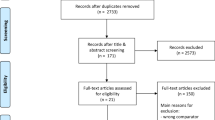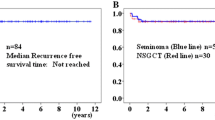Abstract
Objectives
Computed tomography (CT) examinations are frequent in follow-up care of testicular cancer (TC) but may increase the risk for other cancers. We wanted to assess the actual number of CT and X-ray examinations within the first 5 years after a diagnosis of TC in Israel during 2003–2007.
Methods
The database of Maccabi Healthcare Services, Israel, was searched for TC patients diagnosed in 2003 to 2007 by direct linkage with the Israel National Cancer Registry. Data on diagnostic imaging examinations (CT of chest, abdomen, or pelvis, unspecified sites; X-ray of chest) were extracted during a 5-year follow-up for 226 incident patients. The actual number of CT and X-ray examinations was compared to the National Comprehensive Cancer Network (NCCN) guideline. We tabulated the median with 10th and 90th percentiles (P10, P90) for the number of CTs and X-rays considering histology, stage, and adjuvant strategy.
Results
The number of abdomen or pelvis CTs for TC patients receiving chemo- or radiotherapy was in accordance with the NCCN guideline. The median of abdomen or pelvis CTs for surveillance patients was 8.5 (P10, P90: 3; 13) for nonseminoma and 5.0 (P10, P90: 5; 13) for seminoma patients compared to 14 to 17 CTs recommended. The number of chest X-rays was lower than recommended in the guideline for all adjuvant strategies.
Conclusions
The NCCN guidelines regarding CTs were met for TC patients treated with chemo- or radiotherapy but fell below recommendations for surveillance. Guidelines from 2011 and 2012 were updated in favor of fewer CTs during surveillance.
Key Points
• The number of CTs followed the NCCN guidelines in patients treated with chemo- or radiotherapy.
• Surveillance patients received fewer CTs and X-rays than recommended in the NCCN guidelines from 2005.
• The number of applied CT examinations corresponded to a radiation dose that did not substantially raise the lifetime risk for cancer.

Similar content being viewed by others
Abbreviations
- ALARA:
-
As low as reasonably achievable
- AYAS:
-
Adolescents and young adults
- BEIR:
-
Biological Effects of Ionizing Radiation
- CI5C:
-
Cancer in Five Continents
- CT:
-
Computed tomography
- CTX:
-
Chemotherapy
- EAU:
-
European Association of Urology
- FDG-PET:
-
Fluorodeoxyglucose positron emission tomography
- ICD-O:
-
International Classification of Diseases for Oncology
- INCR:
-
Israel National Cancer Registry
- IQR:
-
Interquartile range
- LAR:
-
Lifetime attributable risk
- MHS:
-
Maccabi Healthcare Services
- MRI:
-
Magnetic resonance imaging
- NCCN:
-
National Comprehensive Cancer Network
- RTX:
-
Radiotherapy
- TC:
-
Testicular cancer
- US:
-
Ultrasound
References
Beri A, Matzkin H, Liphshitz I, Barchana M (2007) Epidemiological characteristics and trends of testicular cancer in Israel 1992–2002. Harefuah 146:515–519,575
Znaor A, Lortet-Tieulent J, Jemal A, Bray F (2014) International variations and trends in testicular cancer incidence and mortality. Eur Urol 65:1095–1106
Trabert B, Chen J, Devesa SS, Bray F, McGlynn KA (2015) International patterns and trends in testicular cancer incidence, overall and by histologic subtype, 1973–2007. Andrology 3:4–12
Daugaard G, Gundgaard MG, Mortensen MS et al (2014) Surveillance for stage I nonseminoma testicular cancer: outcomes and long-term follow-up in a population-based cohort. J Clin Oncol 32:3817–3823
Verhoeven RHA, Karim-Kos HE, Coebergh JWW et al (2014) Markedly increased incidence and improved survival of testicular cancer in the Netherlands. Acta Oncol 53:342–350
Schmoll HJ, Souchon R, Krege S et al (2004) European consensus on diagnosis and treatment of germ cell cancer: a report of the European Germ Cell Cancer Consensus Group (EGCCCG). Ann Oncol 15:1377–1399
Motzer RJ, Bahnson RR, Boston B et al (2005) Testicular cancer. clinical practice guidelines. J Natl Compr Canc Netw 3:52–76
Krege S, Beyer J, Souchon R et al (2008) European consensus conference on diagnosis and treatment of germ cell cancer: a report of the second meeting of the European Germ Cell Cancer Consensus Group (EGCCCG): part I. Eur Urol 53:478–496
Nichols CR, Roth B, Albers P et al (2013) Active surveillance is the preferred approach to clinical stage I testicular cancer. J Clin Oncol 31:3490–3493
Brenner DJ, Hall EJ (2007) Computed tomography - an increasing source of radiation exposure. N Engl J Med 357:2277–2284
Pearce MS, Salotti JA, Howe NL et al (2012) CT scans in young people in Great Britain: temporal and descriptive patterns, 1993–2002. Radiol Res Pract 2012:594278
Mathews JD, Forsythe AV, Brady Z et al (2013) Cancer risk in 680,000 people exposed to computed tomography scans in childhood or adolescence: data linkage study of 11 million Australians. BMJ 346:f2360
Miglioretti DL, Johnson E, Williams A et al (2013) The use of computed tomography in pediatrics and the associated radiation exposure and estimated cancer risk. JAMA Pediatr 167:700–707
Smith-Bindman R, Lipson J, Marcus R et al (2009) Radiation dose associated with common computed tomography examinations and the associated lifetime attributable risk of cancer. Arch Intern Med 169:2078–2086
Tarin TV, Sonn G, Shinghal R (2009) Estimating the risk of cancer associated with imaging related radiation during surveillance for stage I testicular cancer using computerized tomography. J Urol 181:627–632
Krege S, Souchon R, Schmoll HJ, German Testicular Cancer Study Group (2001) Interdisciplinary consensus on diagnosis and treatment of testicular germ cell tumors: result of an update conference on evidence-based medicine (EBM). Eur Urol 40:372–391
Bradford TJ, Montie JE, Hafez KS (2006) The role of imaging in the surveillance of urologic malignancies. Urol Clin North Am 33:377–396
van As NJ, Gilbert DC, Money-Kyrle J et al (2008) Evidence-based pragmatic guidelines for the follow-up of testicular cancer: optimising the detection of relapse. Br J Cancer 98:1894–1902
van Walraven C, Fergusson D, Earle C et al (2011) Association of diagnostic radiation exposure and second abdominal-pelvic malignancies after testicular cancer. J Clin Oncol 29:2883–2888
Rusner C, Stang A, Dieckmann KP, Friedel H (2013) Frequency of computed tomography examinations in the follow-up care of testicular cancer patients – an evaluation of patterns of care in Germany. Onkologie 36:188–192
Israel Ministry of Health (2010) Israel Center for Disease Control Health status in Israel 2010. Israel Ministry of Health, Tel-Hashomer
Fritz A, Percy C, Jack A et al (2000) International classification of diseases for oncology, 3rd edn. World Health Organization, Geneva http://www.who.int/iris/handle/10665/42344. Accessed October 2016
Young JL, Roffers SD, Gloeckler Ries LA, Fritz AG, Hurlbut AA (2000) SEER summary staging manual 2000. SEER Program, US National Cancer Institute, Bethesda
Doll R, Cook P (1967) Summarizing indices for comparison of cancer incidence data. Int J Cancer 2:269–279
Forman D, Bray F, Brewster DH, et al (2014) Cancer incidence in five continents, Vol. X. IARC Scientific Publication No. 164. International Agency for Research on Cancer, Lyon. Available via http://ci5.iarc.fr/CI5IX/old/vol10/CI5vol10.pdf. Accessed on 15 Oct 2018
Committee to Assess Health Risks from Exposure to Low Levels of Ionizing Radiation, Board on Radiation Effects, Research Division on Earth and Life Studies, National Research Council of the National Academies (2006) Health risks from exposure to low levels of ionizing radiation: BEIR VII, phase 2. National Acad. Press, Washington, D.C.
Sodickson A, Baeyens PF, Andriole KP et al (2009) Recurrent CT, cumulative radiation exposure, and associated radiation-induced cancer risks from CT of adults. Radiology 251:175–184
Grunau GL, Gueron S, Pornov B, Linn S (2018) The risk of cancer might be lower than we think. Alternatives to lifetime risk estimates. Rambam Maimonides Med J 9(e0002):1–10
Sullivan CJ, Murphy KP, McLaughlin PD et al (2015) Radiation exposure from diagnostic imaging in young patients with testicular cancer. Eur Radiol 25:1005–1013
Grimison P, Houghton B, Chatfield M et al (2013) Patterns of management and surveillance imaging amongst medical oncologists in Australia for stage I testicular cancer. BJU Int 112:E35–E43
Su D, Faiena I, Tokarz R, Bramwit M, Weiss RE (2015) Comparative analysis of the risk of radiation exposure and cost of reduced imaging intensity for surveillance of early stage nonseminomatous germ cell tumors. Urology 85:141–146
Motzer RJ, Agarwal N, Beard C et al (2012) Testicular cancer. clinical practice guidelines. J Natl Compr Canc Netw 10:502–535
Zinsser D, Marcus R, Othman AE et al (2018) Dose reduction and dose management in computed tomography – state of the art. Rofo 190:531–541
Kleinke AM, Classen CF (2018) Adolescents and young adults with cancer: aspects of adherence - a questionnaire study. Adolesc Health Med Ther 9:77–85
McGrady ME, Brown GA, Pai AL (2016) Medication adherence decision-making among adolescents and young adults with cancer. Eur J Oncol Nurs 20:207–214
Smits-Seemann RR, Kaul S, Zamora ER, Wu YP, Kirchhoff AC (2017) Barriers to follow-up care among survivors of adolescent and young adult cancer. J Cancer Surviv 11:126–132
Oliver RTD, Mason MD, Mead GM et al (2005) Radiotherapy versus single-dose carboplatin in adjuvant treatment of stage I seminoma: a randomised trial. Lancet 366:293–300
Barrisford GW, Kreydin EI, Preston MA, Rodriguez D, Harisighani MG, Feldman AS (2015) Role of imaging in testicular cancer: current and future practice. Future Oncol 11:2575–2586
Kok HK, Leong S, Torregiani WC (2014) Is magnetic resonance imaging comparable with computed tomography in the diagnosis of retroperitoneal metastasis in patients with testicular cancer? Can Assoc Radiol J 65:196–198
Dotzauer R, Thomas C, Jäger W (2018) The use of F-FDG PET/CT in testicular cancer. Transl Androl Urol 7:875–878
Nestler T, Baunacke M, Dräger D, Landenberg N, Groeben C, Huber J (2019) Testicular cancer guideline adherence and patterns of care in Germany: a nationwide survey. Eur J Cancer Care 28:e12917
De La Pena H, Sharma A, Glicksman C et al (2017) No longer any role for routine follow-up chest X-rays in men with stage I germ cell cancer. Eur J Cancer 84:354–359
Travis LB, Fossa SD, Schonfeld SJ et al (2005) Second cancers among 40 576 testicular cancer patients: focus on long-term survivors. J Natl Cancer Inst 97:1354–1365
Curreri SA, Fung C, Beard CJ (2015) Secondary malignant neoplasms in testicular cancer survivors. Urol Oncol 33:392–398
Acknowledgements
We thank Eva Bock for her support in the data management and Adi Rennert for her support in organization.
Funding
This study has received funding from the Deutsche Forschungsgemeinschaft (DFG) (grant number RU 1659/4-1) and the Federal Ministry of Education and Research (BMBF) (grant number 01ER1704).
Author information
Authors and Affiliations
Corresponding author
Ethics declarations
Guarantor
The scientific guarantor of this publication is Prof. Dr. med. Andreas Stang, MPH.
Conflict of interest
The authors of this manuscript declare no relationships with any companies, whose products or services may be related to the subject matter of the article.
Statistics and biometry
One of the authors has significant statistical expertise.
Informed consent
Written informed consent was waived by the Institutional Review Board.
Ethical approval
Institutional Review Board approval was obtained.
Methodology
• prospective
• observational
• performed at one institution
Additional information
Publisher’s note
Springer Nature remains neutral with regard to jurisdictional claims in published maps and institutional affiliations.
Electronic supplementary material
ESM 1
(DOCX 21 kb)
Rights and permissions
About this article
Cite this article
Lehnich, AT., Rusner, C., Chodick, G. et al. Actual frequency of imaging during follow-up of testicular cancer in Israel—a comparison with the guidelines. Eur Radiol 29, 3918–3926 (2019). https://doi.org/10.1007/s00330-019-06148-1
Received:
Revised:
Accepted:
Published:
Issue Date:
DOI: https://doi.org/10.1007/s00330-019-06148-1




